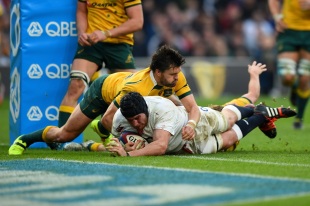|
John Mitchell Column
Six Nations glory means little at World Cup
John Mitchell
February 19, 2015

In Jonathan Joseph, England have a man who can fill Jeremy Guscott's boots © Getty Images
Enlarge
England and Ireland are the only unbeaten teams after two rounds of the Six Nations for a number of reasons. They are both prepared to build scoreboard pressure by taking the three points when on offer and can create pressure with ball in hand when they enter the opposition 22. They are also strong defensively and possess effective set-pieces, with their lineouts, in particular, functioning well. I believe that injuries to a number of first-choice players has actually proved a blessing in disguise and benefited England at large, because it has forced coach Stuart Lancaster to select players whom many pundits believe should have been there in the first place. From a professional coaching perspective, Luther Burrell and Jonathan Joseph have offered England an attacking edge in the midfield, which simply wasn't in effect during the autumn internationals. The 23-year-old Joseph is an X-factor player who reminds me a lot of ex-England international Jeremy Guscott. The Bath back has a unique ability to break tackles, because of the stride of his step, and is a very elegant runner with ball in hand.

England will have to prove themselves against the southern hemisphere sides at the World Cup
© Getty Images
Enlarge
Furthermore, halfbacks Ben Youngs and George Ford have controlled the game well for England, while Danny Cipriani looked sharp when he came off the bench against Italy. He seems to have regained the confidence he lost after being dropped in early 2009 (he does, however, still need to prove himself against a top Test team). I've also been impressed with Dave Attwood at No.4 lock and flanker James Haskell, who has carried the ball strongly and made his presence felt at the breakdown. England have performed well so far in the embryonic stages of the tournament, but I believe we will only be able to gauge how much progress they have made ahead of the World Cup when they play Ireland in Dublin on March 1. That will prove the true litmus test. Comparisons have already been drawn between the current England side and that which won the 2003 Rugby World Cup. But it's important to remember that Clive Woodward's team went into that World Cup having regularly beaten the top southern hemisphere sides, including the All Blacks in New Zealand. As such, they believed they could repeat the feat at the World Cup. While Lancaster's side beat Australia at Twickenham in November, the reality is that they haven't beaten New Zealand or South Africa for a while now, and winning the Six Nations crown won't instil the belief that they can finally do so. We'll also find out a lot more about the Irish from that potential title-decider. To date, they have only played against an average French team and an Italian outfit ranked 14th in world rugby. Ireland are fortunate to boast one of the world's best halfback combinations in Conor Murray and Jonathan Sexton, who kicked six penalties against France on Saturday. With Joe Schmidt at the helm, the Irish also know what they have to do in order to win ugly at times. They adopted a more conservative approach against Italy when they were missing two key players in Sexton and flanker Jamie Heaslip. It wasn't the most entertaining rugby to behold, but it was highly effective.
The big three southern hemisphere teams will be watching England and Ireland with interest, in particular All Black coach Steve Hansen and his Wallabies counterpart Michael Cheika. Australia meet England in the so-called 'Pool of Death', which also contains Wales. Meanwhile, the All Blacks could face Ireland in the quarter-finals. The biggest challenge for the southern hemisphere teams at the World Cup will be about generating quick ball from the breakdown. When it comes to the tackler on the ground not rolling away quickly and the tackle assist player going off his feet, northern hemisphere referees are far more lenient than those in the southern hemisphere, who have been instructed by Sanzar to keep the game moving. The southern hemisphere teams should study the breakdown carefully during this year's Six Nations and come up with a plan to prevent teams like England and Ireland from slowing down their ball. The biggest difference between coaching in the northern hemisphere, as opposed to the south, is how you prepare for the heavy conditions. You can't spend as much time on your feet, so you have to look at ways to accelerate the learning process and keep high-intensity training sessions as short as possible. Because the game is slower in the northern hemisphere, players have defence-orientated mindsets and focus on exit plays that require an excellent set-piece and good kicking. Ball-handling doesn't come as naturally to northern hemisphere players as it does to New Zealanders, for instance, but they do have a good work ethic and are eager to improve. © ESPN Sports Media Ltd John Mitchell's explosive book, Mitch: The Real Story, is available through Amazon (Kindle edition) and Kalahari (print and eBook). Follow him on Twitter @mfactorcoaching
| |||||||||||||||
Live Sports
Communication error please reload the page.
-
Football
-
Cricket
-
Rugby
-
- Days
- Hrs
- Mins
- Secs
F1 - Abu Dhabi GP
Abu Dhabi Grand Prix December 11-131. Max Verstappen ()
2. Valtteri Bottas (Mercedes)
3. Lewis Hamilton (Mercedes)
4. Alexander Albon ()
5. Lando Norris ()
6. Carlos Sainz Jr ()
-
ESPNOtherLive >>
Darts - Premier League
Golf - Houston Open
Snooker - China Open
Tennis - Miami Open

